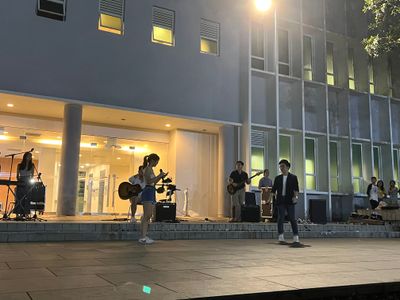“The Mona Lisa has taksu,” Prof Irving Johnson-Chan told the class of SE2224 in seminar five, two weeks before we embarked on a week-long trip to Bali to learn Balinese dance. “Its taksu is what draws its crowds.”
He briefly explained to us that you can be technically brilliant and have no taksu, that you could be an average dancer and have enormous amounts of taksu. It’s a concept unique to Bali and is both a measure of aesthetic and an aspect of spirituality. When you perform, you either have taksu or you don’t, or you gain taksu through the objects you wear as you perform, or you pray to the gods to gain taksu. Some Balinese view taksu as something purely spiritual, something you or an object has to be blessed with, while others view it more akin to a feeling. How do I know if I have taksu? I asked myself, constantly. How will I know if I have taksu when I perform Genggong: the Frog Prince of Bali for my friends and family at LT13, 7pm, on Saturday, 9 November?
(tickets are priced at $25 each; you can DM me @hdbcatlover on tele or whatsapp Prof Irving via the number on the poster below; so sorry for the unskippable ad)
For this performance, the girls learn one dance and the boys learn another, though if you wanted to switch things up you could. Prior to going to Bali, the girls received some basic training by our student assistant Ana, who is a Balinese dancer in her own right and, to the girls’ good fortune, is currently a masters student at NUS and was recruited to be a part of the Genggong production. Every week leading up to the trip to Bali, Ana taught us basic movements: agem kanan (right agem), agem kiri (left agem), piles kanan, piles kiri. She taught us, with utmost patience, how to move our eyes (nyeledet) and how to travel across the floor properly (ngegol). The dance that we are learning is characterised by expressive eye movements, intricate finger movements and intricate footwork.
(Ana demonstrating agem kanan)
My first brush with taksu was watching Ana dance. Whenever she moved, I was mesmerised. She snatched my attention. Even if it was just showing us simple placements of the arm or the leg, there was an innate quality to her movement that I found myself drawn to. It’s not exactly charisma, because there’s a spiritual aspect to taksu. It’s not exactly just being good at it, because at that point I had no way to objectively know how good Ana was.
What is taksu? The question lingered on my mind even as I boarded the plane to Bali.
For a week, we resided in the village of Batuan in Ubud, a cultural hub in the centre of Bali, away from sandy beaches and watersports and the more ‘island living’ hubbub. Our dance lessons were conducted entirely at Kaki Bebek House(Duck Feet House, a cheeky nod to students waddling after their dance teachers like ducklings following their mother). The girls were to practice on a pavilion, led by Ibu Putu while the boys learned from Pak Made Suteja at another part of the compound (Ibu = Ma’am, Pak = Mr).
(The girls at Kaki Bebek House in sarongs and sashes)
The first thing that Ibu Putu told us at Kaki Bebek House was not to rely on the mirror. “It makes you lazy,” she said. “You need to be independent.” I didn’t really understand exactly what she meant, but I swallowed, nodded my head, and got to practicing. Wrapped in sarongs and with little to no breeze to aid us, practicing felt like I was an F1 driver in fireproofs driving the Marina Bay circuit. The heat was so overwhelming Ibu Putu kindly shifted a fan from one of the other pavilions just for us and many of the girls brought another set of clothes to change into after the lessons.
As dance lessons commenced, I thought less about taksu and more about how in the whole wide world is it possible to learn this dance by November 9?
The tale of Genggong is inspired from the Panji tales—myths centred around the Javanese Prince Panji. The girls of SE2224 will be performing the introduction. It has little to no relevance on the broader frog prince plot and is part of a tradition where female dances precede the main story so that the audience is captivated and entertained before the ‘boring’ main plot starts. Quite bluntly, we are there to appeal to a male gaze. However, I think I can hold it within me to acknowledge the dance’s origins and simultaneously understand that this is how they do things, and who am I to be derisive? On the contrary, through actively talking to Ibu Putu and other Balinese dancers to know more about their lived experience, I found the experience quite empowering. Not to mention the shared camaraderie I forged with my fellow classmates dancing, the shared struggle of women uplifting each other, taking the time to sacrifice and help each other.
Well, mostly it was my classmates helping me.
Mentally, it felt like not knowing how to swim and being dumped into the deep end of the pool. Physically, it was hours of bent knees and right-angled arms (like Reeve Carney during his run at the Broadway rendition of Hadestown, but I digress). Spiritually, I felt like a trainee competing on a Korean idol survival show and being awarded the F grade during the judges’ evaluation.
Not to say that the environment resembled Produce 101 and the hellish nature of survival shows — it was quite the opposite, with Ibu Putu and our TA Ana being very very nice, and there being no possibility of me being kicked out halfway through. It was just that at times I felt utterly hopeless. I was unable to do head isolations, for one, and my attempts to practice in front of the mirror in the morning were thwarted by the fact that my neck simply could not move from side to side. Trying to move my feet in tandem with my hands the right way often resulted in me doing the complete opposite, and the more I tried to think through the moves the more I got confused and defeated.
I didn’t think much about taksu until we visited the house of I Made Bandem — a renowned Balinese dancer, artist, and author (among various other titles), and whom the New York Times has featured. He welcomed us students into his traditional Balinese house (or more accurately, a compound), structures with thatched roofs and bamboo poles, and we were invited to sit on pavilions with marble flooring while he stood.
He greeted us with a Rolex on his left wrist, his collared shirt, his batik sarong. His wife offered us food and drink, herself also sporting a Rolex. He moved with a spryness that made it hard to believe he was 80, and spoke with a sharpness that demonstrated his wit.
“If you want to be a good dancer, you need to be a good person,” he said in fluent English. He told us he was born here, in this very house. He told us he was the first Balinese dancer to study in the United States, and briefly I wondered what it must have been to pioneer the art in a place as foreign/hostile as America in a time where civil rights had just burgeoned.
Then he danced. He dragged a chair to the centre of the courtyard, put on his mask, and performed topeng (mask dance) for us.
His dance was captivating, and I mean so in the fullest sense of the word. Not even the frantic flap of a white heron out of the tree line ahead could distract me. Not the butterfly weaving through the crowd, nor the sun beating down on us, nor the humid air with nary a breeze for respite. If I had to explain it in more objective terms, there was a fluidity to his movement, a sense of being that invigorated the entire performance. Every movement was so refined, so controlled, that you needed to pay attention.
Some things just are, and this was. I think it was then that I started to grasp the idea of taksu.
Afterwards, he presented the mask to us. This mask was given to his father by the last King of Klungkung in 1956, he proclaimed proudly, eyes glittering with pride. Musicians in the Balinese court (unlike Javanese ones) were not paid in currency but in gifts, and this had been made by the King himself and given to his father. The mask was old, certainly, and worn, of course, and to the untrained eye it could be considered not particularly outstanding. Yet it was precisely because it was old — handmade by the King; and worn — regularly practiced with, that it teemed with taksu.
(Bandem performing topeng, playing the character of the refined king, wearing the mask given by the last King of Klungkung.)
Perhaps it was then that I started to grasp the simultaneous breadth and depth of taksu, and by extension, the breadth and depth of my efforts to learn Balinese dance. Could I ever understand taksu? Did it matter if I had it or not? My initial preoccupation with trying to define taksu and categorise it had completely missed the point.
It’s a very Singaporean inclination of mine to want to define taksu and to ascertain whether I have it. Like wanting rubrics whenever I have an assessment. Like the Singaporean tendency to portion dance away as an aspect of life in the rat race. Dance in Bali, however, is less a portionable aspect of life and more something that exists in tandem with life. Like one’s blood vessels in tandem with the nervous system. Like the clouds alongside the sky, like the stretch of blue Balinese horizon alongside dusty dirt roads congested with Gojek motorbikes and cars.
One of the anecdotes that I still remember is that of Pak Bandem telling us of how he came to be a dancer; he recounted a story when he was around eight, and the family had been preparing for a funeral at the back of the house. There had been a ritualistic dance going to be performed. His father ordered him to go and dance even if he didn’t know the moves; what mattered was that he partook in the ritual dance.
In Bali, the majority of the population subscribes to Balinese Hinduism, and movement is part of ritual, ritual is part of culture, and to try and separate dance from life would be akin to trying to separate the heart from the body.
Is it not less about whether I have taksu and more of what have I learned in trying to understand it? From a foreigner’s standpoint, I have no business trying to chase some common understanding of taksu when that would probably just result in me overgeneralising the concept. Instead, I should be actually experiencing Balinese dance. The closest I can get to understanding taksu, as a person who’s not very spiritual, is to be in tune with my emotions when I dance.
At the start, Ibu Putu told us not to rely on the mirror. I came to understand why over the course of the week. There’s something about dance that you have to feel, not mechanically look at the mirror and see if your arms are orthogonal. When I do agem kanan it’s a feeling, not a pose I replicate. It’s the pull of your biceps, horizontal to the ground, the poise of your shoulders, not tense but not quite relaxed either. It’s my right foot planted to the ground, the toes of my left lifted. There’s something very freeing about not having to think and just move, to trust your body and do. Something spiritual about it, even. Perhaps it is then that I come close to at the very least being able to grasp the concept of taksu.
On the night before I left, I bonded with Agustin, a Balinese dancer who regularly travels to France to dance, over our shared ability to speak French. She comes from a family of Barong-makers and in her youth, she used to dance for hotels, averaging three performances a day, and was paid 1500 rupiah per performance, pre-Asian Financial Crisis. I asked her how she did it.
“With the correct posture you can hold the agem position for thirty minutes easily,” she said in French. “It’s all about balance.”
To have balance you need to manage the energies in your body, you can't have too much tension in one area and a lack of in another. I need to be at ease when I perform and for that to happen, I need to be in tune with how my body feels and how I feel.
I come away from the week in Bali with a better understanding of taksu, but writing this at the airport at 4am to catch my 7am flight, I find myself filled with a sense of loss. Because when will I experience Bali like this again?
In trying to understand taksu and the art of Balinese dance, I have attempted to live their reality. Of course, there are aspects I will never truly understand. For example, unique to the village of Batuan, the women perform a sacred dance every single night from November to March in order to ward off evil spirits. But the art is in trying to understand, as simple as learning to address men as “Pak” and women as “Ibu”, as slowing down your English and enunciating clearly so they can understand you, as choosing to eat meals with your hands rather than with a fork. And there’s such a joy in meeting a young Balinese girl and having her look at my green highlights and exclaim, “You have Billie Eilish hair!”
(I, sleep-deprived, practicing a no-good agem kiri at 4am at Denpasar airport. I could write another article on how my friend’s posture is exponentially better.)
Perhaps one day I will have taksu. Even better, maybe I’ll have taksu on November 9 when I perform. What I do know, however, is that going to Bali and learning Balinese dance has led me to feel, which I think matters in indifferent, pragmatic, Singapore.






